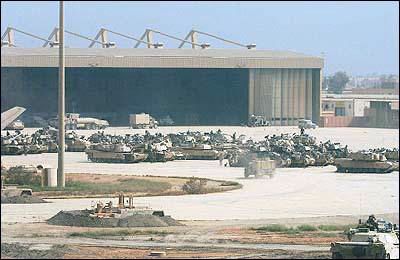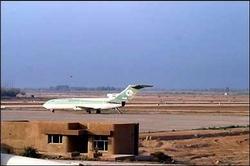Civilian Controllers Head For Iraq
If you ever wondered just how strange a place Iraq was before
the American-led coalition took over, consider this: The windows on
one entire side of the control tower at Baghdad's international
airport were painted black, preventing controllers from seeing
Saddam Hussein's palace (and, oh-by-the-way, any aircraft
approaching from that direction).

"He had the windows on that side of the tower painted over to
prevent controllers from looking down upon him," said Frank
Hatfield, the senior aviation adviser to Iraq, in an interview with
Newsday.
But now, the paint has been peeled off the windows, as a group
of FAA controllers started working in the tower, alongside a
handful of Iraqi civilian controllers. It's a major step in
attempts by the US and the provisional government in Iraq to
restart commercial air travel in and out of the country.
"It's the first step in giving the new Iraqi government control
over their own aviation system," Hatfield said in a telephone
interview with Newsday.
 Scraping the paint off the windows
of the tower was just the beginning for Hatfield. "Most of the
buildings, including the control tower and the passenger terminal,
sustained battle damage and were ransacked or looted. The base
building for the tower, the equipment rooms and the control tower
itself were in very bad condition," he said.
Scraping the paint off the windows
of the tower was just the beginning for Hatfield. "Most of the
buildings, including the control tower and the passenger terminal,
sustained battle damage and were ransacked or looted. The base
building for the tower, the equipment rooms and the control tower
itself were in very bad condition," he said.
As of Tuesday, the Iraqi civilians were in charge of Baghdad's
airport, with FAA controllers like Hatfield looking over their
shoulders. Hatfield, who was the FAA official responsible for
shutting down the airspace over New York on 9/11, has a big job
ahead.
For now, Hatfield, his FAA team and their Iraqi counterparts
only have partial control of the airport. Controllers from the
Royal Australian Air Force, working in a room directly above the
civilians, coordinate military traffic on the west runway, while
the civilians control the runway on the airport's east side. You
can guess which runway is busier.
Only a few civilian flights -- mostly relief and reconstruction
charters -- arrive and depart Baghdad each day. Security is still a
huge concern, especially after a SAM attack almost downed a DHL
flight taking off from Baghdad earlier this year. Hatfield told
Newsday the threat of missile attacks is still very much in the
minds of both civilian and military controllers.

"Once that threat is at an acceptable level, they'll have
scheduled service," Hatfield said. "It's not a date; it's a
goal."
 For now, Hatfield is senior aviation
adviser to the Iraqi provisional government. He'll hand over that
title when the US officially returns sovereignty to Iraq on June
30th. He will, however, stay on as a consultant, as will several
members of his team.
For now, Hatfield is senior aviation
adviser to the Iraqi provisional government. He'll hand over that
title when the US officially returns sovereignty to Iraq on June
30th. He will, however, stay on as a consultant, as will several
members of his team.
"There are two things every country in the world wants: a
national flag carrier and regularly scheduled air service to
connect them to the rest of the world," said George Novack of
George Washington University's Aviation Institute, also interviewed
by Newsday. Bringing civilians back into the control tower "is a
clear demonstration to the aviation community that things are
headed toward normalcy."
 ANN's Daily Aero-Linx (05.02.24)
ANN's Daily Aero-Linx (05.02.24) ANN's Daily Aero-Term (05.02.24): Touchdown Zone Lighting
ANN's Daily Aero-Term (05.02.24): Touchdown Zone Lighting Aero-News: Quote of the Day (05.02.24)
Aero-News: Quote of the Day (05.02.24) ANN FAQ: Contributing To Aero-TV
ANN FAQ: Contributing To Aero-TV NTSB Final Report: Cirrus Design Corp SR20
NTSB Final Report: Cirrus Design Corp SR20






